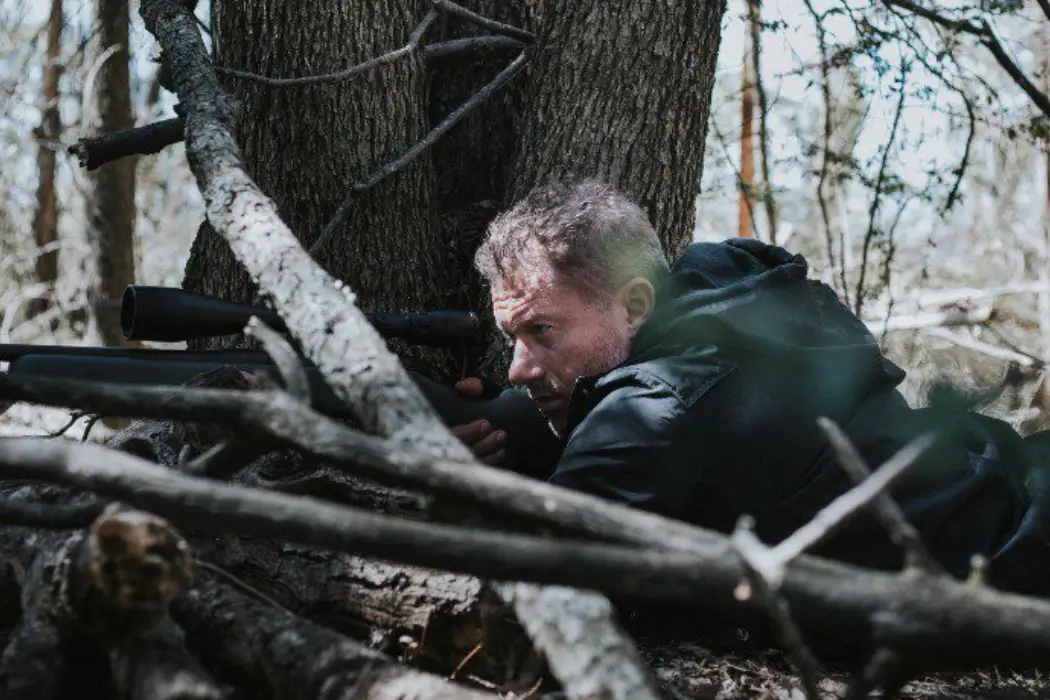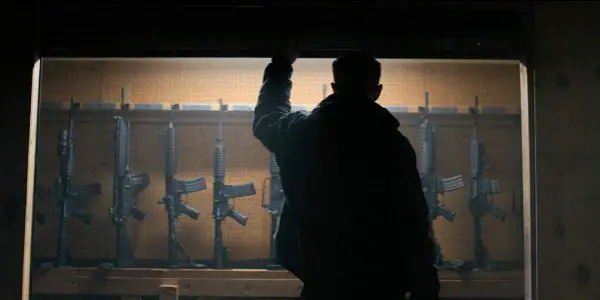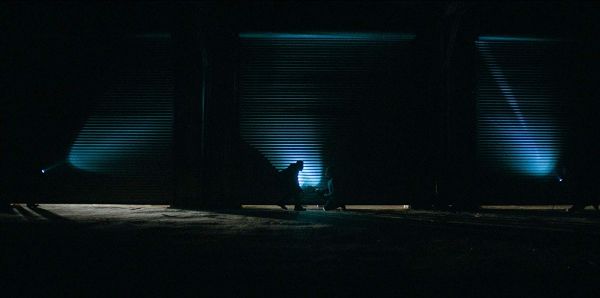THE STANDOFF AT SPARROW CREEK: Militia Men Stuck In A Who-Dun-It

I'm a student at the University of North Carolina at…
In the dead of night, seven members of a reclusive militia show up at a deserted warehouse. A few miles away, a heinous and disturbing mass shooting has been committed. The victims? All cops – it was a funeral for a police officer. The militia members, with their reputations as angry, anti-law enforcement gun nuts, know they’ll be the first suspects. Ford (Chris Mulkey), the de facto leader of the group, wants to call the cops to firmly express that this group was not involved, until he discovers that an AR-15 rifle is missing – including some kevlar and a few grenades. Suddenly, the militia comes to a harrowing conclusion – this attack was carried out by one of their own.
This, essentially, is the setup for Henry Dunham‘s The Standoff at Sparrow Creek, which has the ominous aura of a grungy thriller and the talky charms of a stage play. With a brisk running time and a sufficient degree of unpredictability, the film unspools like an engaging mystery, one predicated on the viewer’s ability to read each character’s poker face with a certain degree of skill. It’s the kind of movie where you’re positive that a number of twists are coming – you’re just not sure what they’ll be.
Yes, writer/director Dunham indulges the chatterboxes of his script far too often and feels the need to spell out his clever ending, but there’s enough atmospheric intensity and definitely enough scene-chewing excess to overlook the flaws.
Paranoia Spreads After Vicious Attack
At the center of the story is Gannon (James Badge Dale), a former cop who left the force for reasons only disclosed further down the line. He lives a life of solitude, alienated from his family and many of his former colleagues, and even though he’s a member of this heavily armed, seriously dangerous militia, one never gets the sense that he’s that committed to the cause. Perhaps for that reason alone, Ford puts him in charge of the investigation; he’s now responsible for interrogating every member of the group in search of possible motives or missteps in their alibis.

Gannon already knows a few people don’t quite have the cruelty – or the motivation – within them to pull something like this off. Beckmann (Patrick Fischler), a local high school teacher and the group’s resident tech nerd, gets crossed off his list pretty early, as does elderly hunter Hubbel (Gene Jones). Soon enough, it’s clear that Gannon is also in on a pretty big secret – one of the group’s members, Noah (Brian Geraghty), is actually an undercover cop. So that crosses Noah off the list – even though he showed up late to the hastily assembled meeting – but it puts Gannon in a precarious position within the group. Instead of revealing his secrets, he focuses all attention on Keating (Robert Aramayo), a silent Holden Caulfield wannabe with plans in his locker to shoot up his school, and Morris (Happy Anderson), an ex-Nazi with a grudge against local cops.
A Mystery Partial to Simmering Thrills
But as the conspiracy deepens, is it possible that these suspects are too obvious?
Since the film’s world premiere in the Midnight Madness section of last year’s Toronto International Film Festival, The Standoff at Sparrow Creek has drawn comparisons to Quentin Tarantino‘s Reservoir Dogs, which is an understandably familiar reference point. Both films put undesirable characters in a single environment, allowing them to slowly investigate each other and reveal deeply buried secrets. But beyond the geographical and basic narrative similarities, the two films employ wildly different strategies to reach some unpredictable third act surprises. Tarantino‘s band of trigger happy jewel thieves and this group of paranoid doomsday 2010s, 2018, drama, thriller, Who both like to talk a lot, but all that chatter comes in pursuit of unique goals.

Notably, Dunham doesn’t share Tarantino‘s penchant for extreme violence, preferring to let the nasty events of the story exist only in the viewer’s imagination. At first, this almost increases the intensity of the whole endeavor; I felt certain that the steady momentum would eventually explode into something horrifying. But Dunham‘s clinical approach doesn’t allow for that kind of grimy messiness, preferring to let the blood and gore linger in the shadows just out of our view. In fact, as the twists pile up and the narrative sleight-of-hand comes into focus, it’s ultimately clear that Standoff at Sparrow Creek shares more DNA with something like Murder on the Orient Express than it does with any kind of icky midnight entertainment.
Needless Monologues, Expert Atmosphere
And while that may seem like a disappointing subversion of expectations, I found the slow burn to be effective. Dunham is a strong and steady craftsman, combining Adam Dietrich‘s desolate production design and Jackson Hunt‘s stark cinematography for an effect of decrepit isolation, playing with the geography of this locale in a satisfying manner. The minimal action is staged with a special kind of eeriness in mind, one that’s rooted in an unnerving sense of stillness. Sparrow Creek is a shadowy, overly serious affair, and every element of its narrative and craft reflects the film’s white-knuckle grip.

However, “overly serious” is a key term here. When a certain character began to spout their own brand of pseudo-philosophical, existential drivel, I could feel things start to fall on shakier ground. Dunham has a message in mind here, but it only arrives in the final seconds (which are brilliant, if I may add), making the second half of the build-up feel a bit superfluous and only enhancing the stage-y vibe. At a certain point, I think the film believes it’s a tad smarter than it actually is, which trickles down from the relentless monologues to the explanation-heavy finale. Simply put, I wanted more room to breathe – and certainly more room for levity – than this film was willing to provide.
The Standoff at Sparrow Creek: Conclusion
But despite the ever-increasing grimness of this standoff, Dunham gets one key thing right: pacing. If you’re going to make a compact thriller like this, the pace can never lag, and it thankfully never happens here. For a first-time feature, Dunham has assembled a top-notch crew of character actors, and he lets them get to work in a blunt, efficient manner. James Badge Dale, with his vicious interrogations and own lingering sense of moral self-doubt, practically carries the movie at a certain point, operating in a spiritual limbo that puts him somewhere between righteousness and anarchy.
Nobody does modern noir anxiety quite like Badge Dale, and The Standoff at Sparrow Creek allows Gannon to end at a moment of crushing uncertainty. For all its shortcomings, something about that final shot makes it all click.
What did you think of The Standoff at Sparrow Creek? Are you a fan of this kind of contained thriller? Let us know in the comments below!
The Standoff at Sparrow Creek was released on demand in the US on January 18, 2019. For all international release information, click here.
Does content like this matter to you?
Become a Member and support film journalism. Unlock access to all of Film Inquiry`s great articles. Join a community of like-minded readers who are passionate about cinema - get access to our private members Network, give back to independent filmmakers, and more.
I'm a student at the University of North Carolina at Chapel Hill. For 8 years, I've edited the blog Martin on Movies. This is where I review new releases, cover new trailers, and discuss important news in the entertainment industry. Some of my favorite movies- Casablanca, Inception, Singin' in the Rain, 2001: A Space Odyssey, The Wolf of Wall Street, The Nice Guys, La La Land, Airplane!, Skyfall, Raiders of the Lost Ark. You can find my other reviews and articles at Martin on Movies (http://martinonmovies.blogspot.com/).













